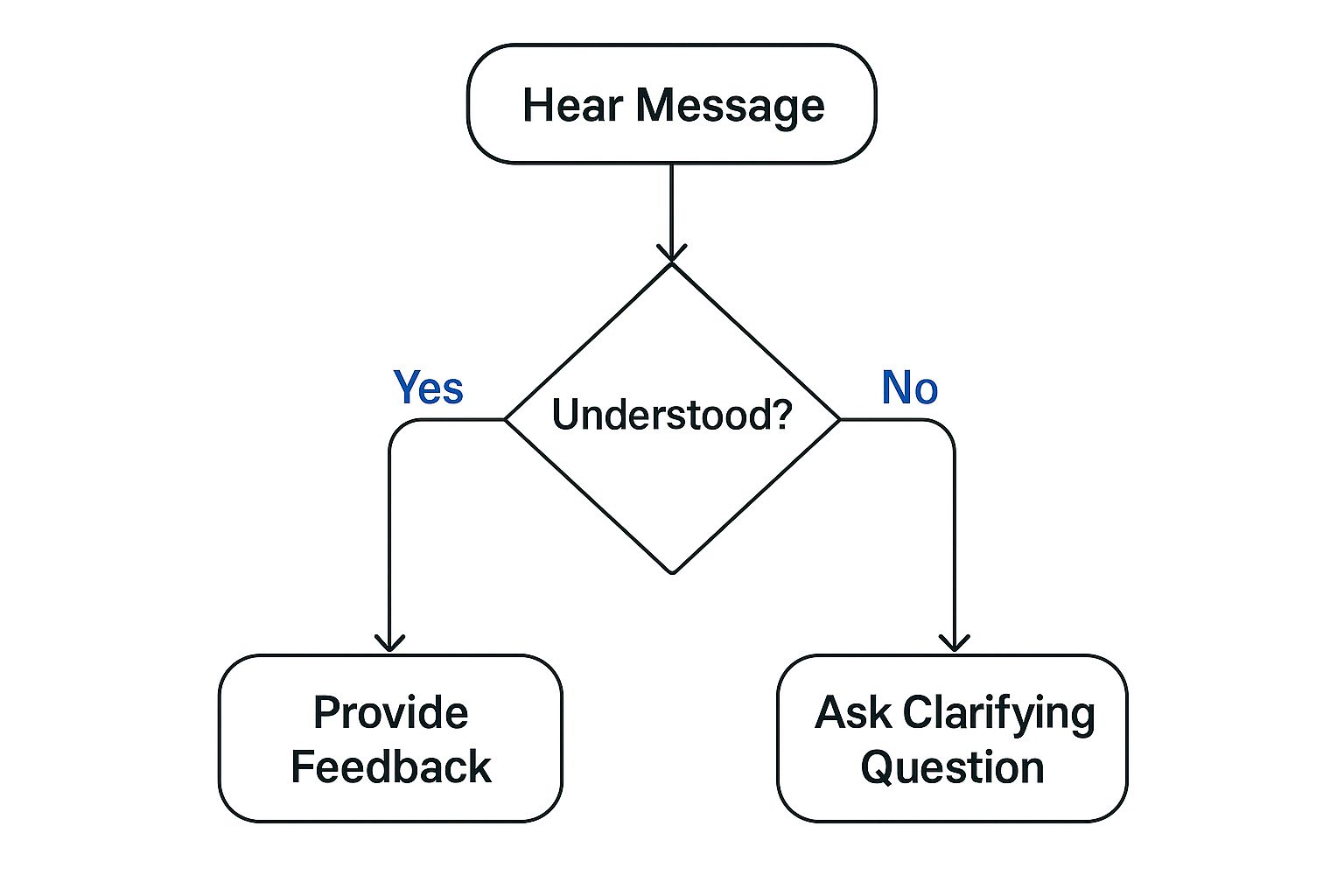Let's be blunt: poor communication isn't just a minor annoyance or a 'people problem'—it's a direct hit to your bottom line. Investing in communication skills training for employees isn't about ticking a 'soft skill' box. It's about building a core business competency that creates a more resilient, aligned, and productive team from the ground up.
Why You Can’t Afford to Ignore Communication Training

It's tempting to think of communication as something intangible, but its effect on your business is anything but. When communication breaks down, the fallout is real and costly. We’ve all seen it: missed deadlines, frustrated clients, and projects that go completely off the rails. This isn't just a feeling; the numbers back it up.
The cost of these communication disconnects to UK productivity is staggering. Global research paints a stark picture, with a massive 86% of employees and executives pointing to ineffective communication and poor collaboration as the main reason for failures at work. On the flip side, getting it right pays dividends. Teams with highly effective communication can boost their productivity by as much as 25%. That’s a figure that speaks directly to operational efficiency and, ultimately, revenue. If you're interested in the data, you can explore these communication statistics and their impact in more detail.
Before we dig deeper, let's look at the hard numbers. The contrast between poor and effective communication is not subtle; it shows up in everything from project outcomes to employee loyalty.
The Business Impact of Workplace Communication
The data makes it clear: communication is a financial issue. Ignoring it is a choice to accept lower productivity and higher turnover.
From ‘Soft Skill’ to Core Competency
For decades, communication has been unfairly branded a "soft skill," implying it's a nice extra rather than a business necessity. This is a dangerously outdated view. In reality, it's the bedrock of almost every critical business function.
Think about these all-too-common scenarios:
- A project manager gives a vague brief, leading to weeks of expensive rework.
- A salesperson misreads a client's core need and loses a major deal.
- A manager fumbles constructive feedback, causing a star employee to become disengaged and start looking elsewhere.
In every case, the root cause isn't a lack of technical skill. It's a communication breakdown. Good training gives your team the practical tools to prevent these costly mistakes from ever happening.
The truth for any modern business is simple: if you're not actively training communication skills, you're actively choosing to leave productivity, engagement, and revenue on the table.
The Tangible Returns on Your Investment
Putting resources into your team's communication abilities delivers very real, measurable returns. Businesses that make this a priority see dramatic improvements across the board. Team performance and efficiency shoot up because clear instructions eliminate confusion and wasted effort. Projects simply run better when everyone is on the same page.
But the benefits don't stop there. A culture of open, respectful communication has a direct and powerful effect on employee engagement and retention. When people feel heard and respected, their motivation and loyalty grow. This creates a positive cycle where better morale drives even greater productivity, fundamentally improving your entire workplace.
Diagnosing Your Team's Communication Gaps
Before you can roll out any effective communication skills training, you first have to figure out where the real problems are. Jumping straight into a generic programme without a proper diagnosis is like trying to fix a car without even lifting the bonnet. You're just guessing. What you really need is solid data to pinpoint the specific communication gaps holding your team back.
Assumptions just won't cut it. A more structured approach lets you move past hunches and identify the root causes of friction and inefficiency. Are your issues mostly cropping up in written communication, like muddled emails or confusing reports? Or do they tend to surface during team meetings, client presentations, or even in simple one-to-one chats between managers and their staff?
Uncovering the Hidden Issues
To get a truly clear picture, you’ll want to use a mix of methods. Think of it like putting a puzzle together; each approach gives you a different piece, helping you build a complete understanding of your team's unique challenges.
I've found combining these works best:
- Anonymous Surveys: These are fantastic for getting honest, unfiltered feedback. You can ask very specific questions about how effective meetings are, whether instructions from leadership are clear, and how comfortable people feel giving and receiving constructive criticism.
- Focus Groups: Getting small groups together for a facilitated discussion can bring out nuanced issues that surveys often miss. For instance, a group of junior employees might open up and reveal they feel too intimidated to ask questions in larger team meetings—something they'd never write in a survey.
- Performance Review Insights: Take a good look through past performance reviews and search for patterns. If you see multiple reviews mentioning a need for better collaboration between departments or clearer project updates, you've struck gold. That's valuable data right there.
I’ve seen this happen time and again: a major disconnect exists between the leadership’s strategic goals and what the team is actually working on day-to-day. When that’s the case, it's almost always a communication problem that you can trace back to its source, giving you a clear starting point for training.
From Data to Diagnosis
Once you've gathered all this information, it's time to sift through it for recurring themes. This process is very much like conducting a skills gap analysis, where you're pinpointing the exact skills your team needs to build. To get a head start, you might find it useful to review our guide on conducting an effective skills gap analysis. Following a structured approach like this helps turn raw feedback into a concrete, actionable training plan.
For example, your analysis might show that while your team is great at quick, internal chats, their formal email communication with clients is often far too casual or riddled with grammatical errors. Right away, this tells you exactly where to focus your training budget and effort.
This lack of strategic alignment is a surprisingly common problem. In fact, a recent UK survey found that only 48% of employees felt they had been clearly informed about their organisation's strategic goals. Even worse, just 40% understood their specific role in helping to achieve them. These figures point to a critical leadership communication gap that has a direct impact on performance. You can dig into more of these findings from the UK workforce preparedness study on itbrief.co.uk.
By taking the time to properly diagnose these gaps up front, you ensure that your investment in communication skills training is targeted, relevant, and actually capable of delivering real, lasting change.
Designing Training That Actually Changes Behaviour

We've all sat through generic, one-size-fits-all training sessions that led to precisely zero change. To actually foster new skills, your programme has to be built around the real-world challenges your team faces every single day. Effective design isn't about abstract theory; it's about practical application.
This means getting away from passive lectures and embracing active participation. The most powerful communication skills training for employees is grounded in realism, giving people a safe space to practise new techniques before they have to use them under pressure.
True behavioural change doesn't come from watching a presentation. It comes from doing, reflecting, and refining—turning learned knowledge into muscle memory.
Build Modules Around Real Scenarios
Forget broad topics like "Better Emails." Instead, create modules that target specific, high-stakes situations your team actually encounters. This makes the content instantly relevant and gives employees tools they can put to use the very next day.
Think about developing focused training around scenarios like these:
- For managers: A session on giving difficult performance feedback in a way that motivates improvement, not defensiveness. This could involve working with scripts, engaging in role-play, and practising tone modulation.
- For client-facing staff: A workshop on de-escalating tense conversations with unhappy customers, focusing on active listening and empathetic language that validates their concerns.
- For project teams: A practical guide to running more efficient meetings, covering how to set a tight agenda, keep discussions on track, and walk away with clear, agreed-upon action items.
This targeted approach makes the learning stick because it directly solves a problem your employees are already grappling with. It's also a crucial part of developing a wider virtual team communication plan, as it tackles the specific friction points of remote work head-on.
Structure Content For Lasting Impact
How you structure your content is just as vital as what's in it. A great training curriculum should feel like a continuous development journey, not a one-off seminar that's forgotten by Monday morning.
The key is to build a curriculum that caters to different learning styles and reinforces core concepts over time. Here in the UK, the value of well-designed communication skills training for employees is getting the recognition it deserves. For instance, Cambridge Advance Online’s Compelling Communication Skills course was celebrated at the Learning Technologies Awards for its exceptional design, which led to demonstrable professional growth for its learners.
That award-winning programme proves that thoughtful design delivers tangible results. The goal is to create a sequence of learning experiences that build on one another, gradually increasing both competence and confidence.
From a Single Event to Ongoing Development
To make your training truly stick, you have to think beyond the initial session. Your design must include elements that support ongoing practice and reinforcement right back at the desk.
Here’s a simple but effective way to embed the learning:
- Pre-Work: Send out short readings or reflection questions to get participants thinking about the topic before the session even starts.
- Interactive Session: Dedicate the live training time to role-playing, group problem-solving, and valuable peer feedback.
- Post-Training Application: Give employees simple, actionable "homework," like trying out one new skill in their work over the next week.
- Follow-Up: Schedule brief check-in meetings or open a dedicated chat channel where the team can share successes and troubleshoot challenges together.
This approach transforms training from a forgettable event into a sustained process, making it far more likely that new, positive behaviours will become permanent habits.
Choosing Your Training Delivery Method
Figuring out how you'll deliver your training is just as important as deciding what to teach. The right delivery method is the difference between lessons that resonate and lessons that are forgotten the moment a session ends. Your final choice will come down to a mix of practicalities – things like your team’s size, where they're based, your budget, and, most importantly, what you’re trying to achieve.
The classic in-person workshop is still a powerful tool for a reason. There’s something special about getting everyone in a room together. It’s perfect for practicing the finer points of communication, like reading body language or navigating tough conversations through hands-on role-playing exercises. But let's be realistic: for teams spread across the country or the globe, this can quickly become a logistical and financial nightmare.
Finding the Right Fit for Your Team
This is where more modern, digital approaches really shine. Self-paced e-learning modules offer fantastic flexibility, letting your team learn whenever and wherever works best for them. It’s a brilliant, cost-effective way to get foundational knowledge across, but it often misses the spark of live interaction and immediate feedback.
For many companies I work with, especially those with a remote-first culture, Virtual Instructor-Led Training (VILT) hits the sweet spot. VILT gives you the direct, engaging feel of a live workshop but through the convenience of platforms like Zoom or Microsoft Teams. Using features like breakout rooms and live polls keeps people actively involved. It's an excellent way to build connections across different locations without the hefty travel bill.
Another route that’s gaining a lot of traction is a blended learning model. This approach is the best of both worlds, mixing self-paced online learning with live sessions (either virtual or in-person). Your employees can get their heads around the core concepts on their own schedule, and then everyone comes together for focused, practical application and expert coaching.
A mistake I see all too often is companies picking a delivery method purely based on cost or what seems easiest. The best training programmes always match the method to the learning goal. If you want to see real behavioural change, interactive practice is essential. If it's just about transferring information, self-paced learning can be incredibly efficient.
Comparing Training Delivery Methods
Deciding can feel overwhelming, so it helps to lay out your options. This table breaks down the most common methods to help you see which one aligns best with your team's needs and training objectives.
Ultimately, there's no single "best" method. It’s all about finding the right tool for the job.
A Framework for Your Decision
Making a smart choice starts with understanding the skills you're trying to build. Take active listening, for example—it’s the bedrock of almost every other communication competency.
This visual breaks down what active listening really involves. It’s not a passive activity, but a dynamic cycle.

As the graphic shows, effective listening is a continuous loop of hearing, understanding, and responding. This is a skill that absolutely has to be practised in real-time, which is why interactive training methods tend to be so much more effective for developing it. By carefully weighing your team's specific needs against the unique strengths of each delivery method, you can design a programme that delivers a real, measurable impact.
Measuring the ROI of Your Communication Training

Investing in communication skills training for employees feels like the right thing to do, but how do you actually prove it worked? To justify the time and budget, and frankly, to get it signed off again, you need to show a clear return. This means going far beyond the simple "Did you enjoy the session?" feedback forms.
The trick is to measure what truly matters. We need to look at what people learned, sure, but more importantly, we need to see how their behaviour changed back on the job. The ultimate win is connecting those new behaviours to real, bottom-line business results.
Don’t just measure satisfaction; measure impact. The real value of communication training isn't found in happy-sheets, but in observable improvements to how your teams work together and how your business performs.
From Knowledge Gain to Behavioural Change
First things first, you need a starting line. You can't possibly measure improvement if you don't know where your team stood in the first place. This is where pre- and post-training assessments are worth their weight in gold.
Before a single training module is delivered, you have to get a handle on your team's current capabilities. This baseline data is what you’ll use to show concrete progress later on. For a really structured approach, using a formal communication skills assessment provides a solid, evidence-based starting point.
Here’s how I’d tackle it:
- Before the Training: Use a blend of methods. Quizzes can test knowledge on things like the principles of active listening. But you also need scenario-based questions to see how they apply it—think "How would you respond to this angry client email?"
- After the Training: A few weeks later, issue the same (or a very similar) assessment. A significant jump in scores gives you hard evidence that the knowledge stuck.
- On-the-Job Checks: This is where you see if the training really worked. For example, you could review a sample of outgoing client emails from before the training and compare them to a sample from after. Are they clearer? Is the tone better? That's your proof.
Connecting Training to Business KPIs
The most powerful way to prove ROI is by linking improved communication directly to your key performance indicators (KPIs). This is where you translate better skills into tangible business success. It takes a bit of strategic thinking, but the payoff is huge.
You need to pinpoint which business metrics are most likely to be affected by better communication. Go back to the specific problems you identified at the start and figure out how to measure them.
Think about these kinds of scenarios:
- For fewer project mistakes: If your training was about writing clearer project briefs and running better kick-off meetings, track the number of change requests or the amount of rework needed. A decrease of even 10-15% in rework adds up to serious cost savings.
- For faster customer support: If a team was trained on email clarity, measure the average time it takes them to resolve a customer query. Trimming hours or even days off that metric is a direct win for customer satisfaction.
- For better sales figures: Let's say your sales team got a masterclass on presentation skills. Compare their close rates from the quarter before the training to the quarter after. A clear increase shows a direct financial return.
By tracking concrete numbers like these, you shift the entire conversation. Training is no longer just a cost; it’s a strategic investment that actively drives the business forward.
Sustaining Communication Skills for the Long Term
A brilliant one-day workshop can create a real buzz, but that energy fades fast if it isn't channelled. Let's be honest: the real work in communication skills training for employees begins long after the flip charts are packed away. To see a genuine return on your investment, you have to embed these new skills into the very fabric of your company culture.
True, lasting improvement comes from daily reinforcement, not just a one-off event. The goal is to shift from a training session to a cultural standard, where clear, effective communication is simply how things are done around here. This doesn’t happen by accident; it takes a deliberate, sustained effort to build an environment that supports continuous practice and growth.
Embed Communication into Daily Operations
For new skills to stick, they have to become part of the daily grind—the meetings, the emails, the project updates. When good communication is woven into your team's core processes, it stops feeling like a chore and starts becoming second nature.
This means looking beyond the training room and spotting opportunities for reinforcement in everyday work. It often starts with small but meaningful tweaks to how your teams collaborate and how you measure individual contributions.
Here are a few practical ways to get started:
- Peer Coaching Circles: Get small, informal groups of employees together regularly. Let them talk through their communication challenges and wins in a safe space. It’s a fantastic way for them to practise new techniques, give honest feedback, and keep each other on track.
- Manager-Led Reinforcement: Your managers are your most powerful allies here. Train them not just to model great communication in their own emails and meetings, but also to provide on-the-spot coaching when they see a chance for someone on their team to improve.
A common mistake is to tick the "training complete" box and move on. Lasting change is a marathon, not a sprint. It’s the small, consistent reinforcements that build the muscle memory for better communication across your entire organisation.
Link Skills to Performance and Growth
Nothing signals that something is truly important like tying it to performance reviews and career progression. When your team sees that their communication abilities directly impact their professional growth, their motivation to improve skyrockets.
Weaving communication goals into your performance management system sends a clear, powerful message: these aren't just "soft skills," they're core competencies. They are valued just as much as technical expertise or hitting sales targets.
For example: ditch vague goals like "improve communication." Instead, set a specific, measurable objective. Try something like, "Successfully lead three project meetings using the agenda and facilitation techniques from the training," or "Reduce email misunderstandings by adopting the 'clear subject line' and 'action-oriented summary' principles we covered."
By making communication a tangible part of performance evaluations, you ensure your investment in training delivers real, lasting value and helps foster a culture of excellence.
Frequently Asked Questions About Communication Training
It's completely normal to have a few questions when you're thinking about bringing in a new initiative like communication skills training. You want to be sure you're making a smart investment, and that means getting clear on the practical side of things—from how you'll measure success to how often this should even happen. Let's walk through some of the most common queries I hear from leaders.
How Can We Measure the Effectiveness of Training?
This is the big one, isn't it? The good news is that measuring the impact of communication training goes way beyond happy-sheets and feedback forms. Real effectiveness shows up in tangible, observable changes in how your teams work together.
You'll know it's working when you see:
- Better collaboration in action: Are your meetings sharper and more productive? Do projects that span multiple departments seem to move along with less friction and fewer misunderstandings? A noticeable improvement here is a powerful sign of success.
- A lift in employee engagement: You can use pulse surveys before and after the training to get a read on morale and whether people feel more heard and valued. A positive shift often goes hand-in-hand with better communication.
- Improvements in key business metrics: This is where the rubber meets the road. Look for a reduction in project delays caused by wires getting crossed, or even a bump in customer satisfaction scores. Those hard numbers provide the clearest evidence of your return on investment.
How Often Should Communication Skills Training Happen?
Communication isn't a "one-and-done" topic. It's a skill, and like any skill, it gets rusty without regular practice. If you want the training to stick, you need to think of it as an ongoing process, not a single event.
I always advise clients to see it as a development cycle. You might kick things off with a more intensive workshop, but the real magic happens with consistent reinforcement. Holding shorter, focused sessions on a monthly or quarterly basis is a fantastic way to keep these skills top of mind. This approach allows people to build on what they've learned and truly embed good communication habits into their daily work.
The most successful training programmes treat communication as a core competency that needs regular maintenance, much like any other critical business skill. It’s about building a culture, not just completing a course.
Can This Training Be Customised for Our Specific Challenges?
Absolutely—in fact, it must be. A generic, off-the-shelf course is a bit like a one-size-fits-all t-shirt; it rarely fits anyone perfectly. Your organisation has its own unique communication hurdles, and the training needs to address them head-on.
A good training partner will dig in with you to:
- Pinpoint the specific issues your teams are wrestling with. Is it conflict between departments? Is it about writing clearer, more persuasive client emails?
- Shape the content, exercises, and role-playing scenarios to mirror the real-world situations your employees face every single day.
This tailored approach is what makes the training relevant and gives your people practical tools they can put to use the moment they're back at their desks.
What Is a Typical Duration for a Training Session?
There's no single answer here, as the ideal length really depends on what you're trying to achieve and how deep you need to go. Generally, though, sessions fall into a few common formats.
Common Training Durations
Ultimately, the best choice hinges on your goals. Are you looking for an immersive experience to launch a company-wide initiative, or do you need a steady rhythm of shorter sessions to ensure continuous improvement?

